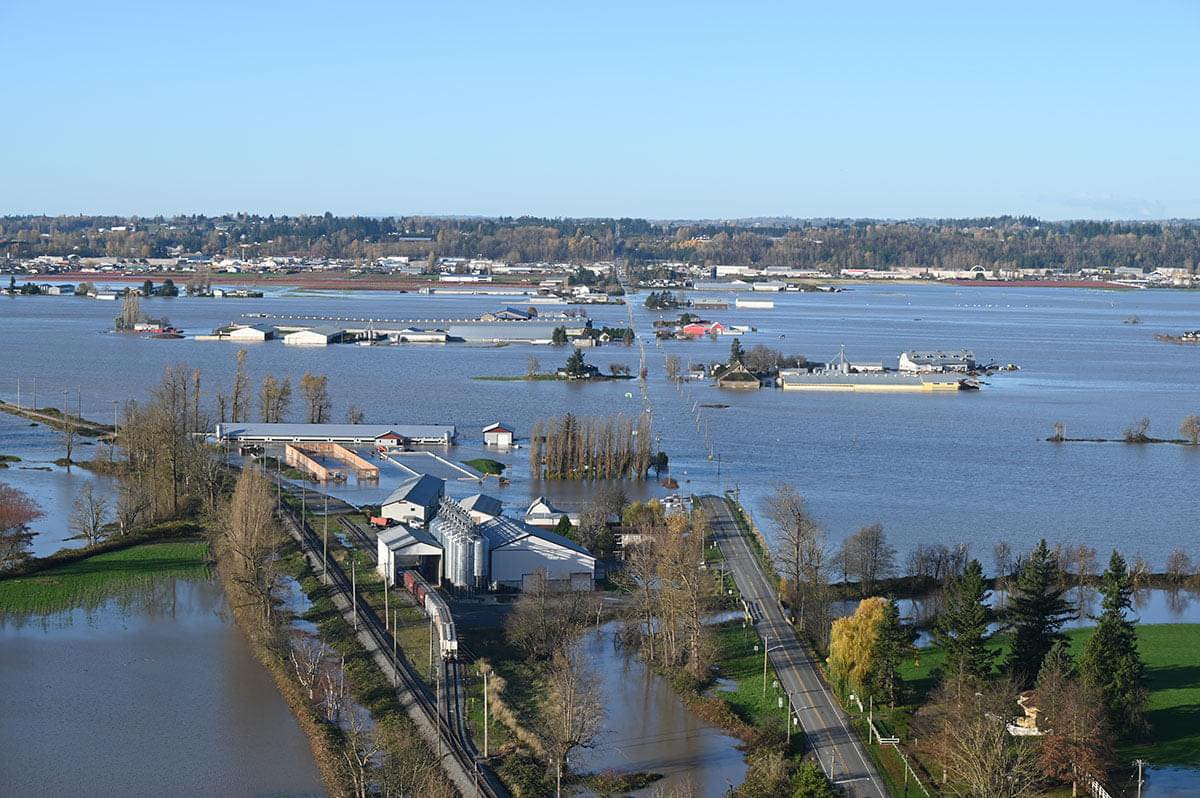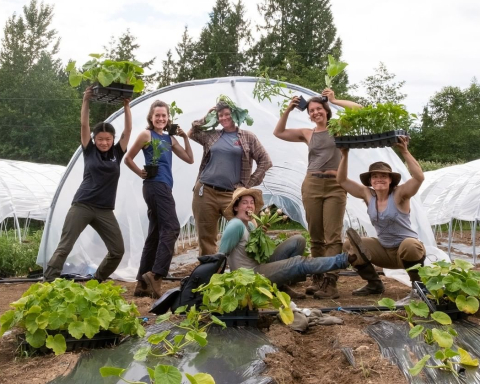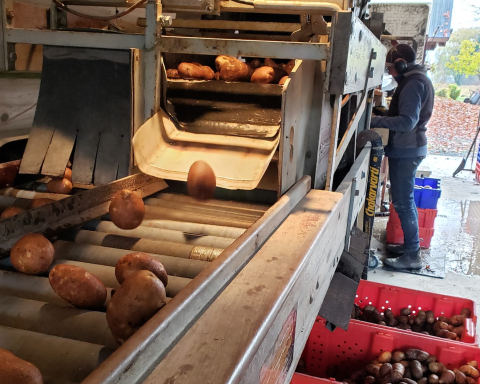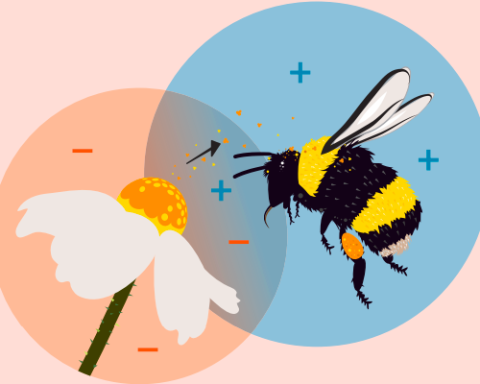Atmospheric Rivers
Niklaus Forstbauer – Forstbauer Farm, Chilliwack
How do I even begin to describe the month of November for those of us who live in the path of catastrophic weather systems that unleashed flooding, landslides, and washouts throughout our region?
It is difficult to express the dread: the rain falling, water rising around houses and barns, flowing across roadways… Trying to steal a few hours of sleep with the rain pounding hard and no end in sight (and when the rain finally did stop, the flood waters kept rising!). It’s something that has to be experienced to really be understood.
The majority of our farm was under water and machinery had to be pulled to high ground. Livestock had to be moved—keeping them safe, dry, and fed proved to be the most difficult challenge to farmers in this situation. The horrendous toll to animals in BC weighs heavy on the heart of every farmer.
Then we were hit by strong winds. One of our 200-foot cold frame greenhouses (which also serves as a shelter for our chickens) was pulled out of the saturated ground by the strong winds. We waded through three-foot deep water to cut the poly from several of our other cold frames that still had crops in as the wind began to lift them also. On our way in from this devastation I caught a photo of Travis fielding a call from the media (the first of many) seeking comment on the rainstorm, unaware of the fact that we were literally in the midst of it… And that was just the first of several systems to roll through!
One has to step back and wonder “What is going on?” This summer we experienced several weeks of record-breaking temperatures leading to catastrophic fires during the ‘heat dome,’ and this fall British Columbians were introduced to another new term as we experienced several ‘atmospheric rivers’ causing more devastation—and of course there is the global pandemic that still lingers after two years of lockdown. Nature is full of rhythms and cycles, destruction and regeneration. As farmers we see it all around us every day. I’ve recently noticed that when folks ask Travis about an issue on their farm (pests, drought) he’ll point out that the answer is usually there: Nature is trying to tell them something.
Anyway, it’s worth pondering, what is Nature trying to tell us?
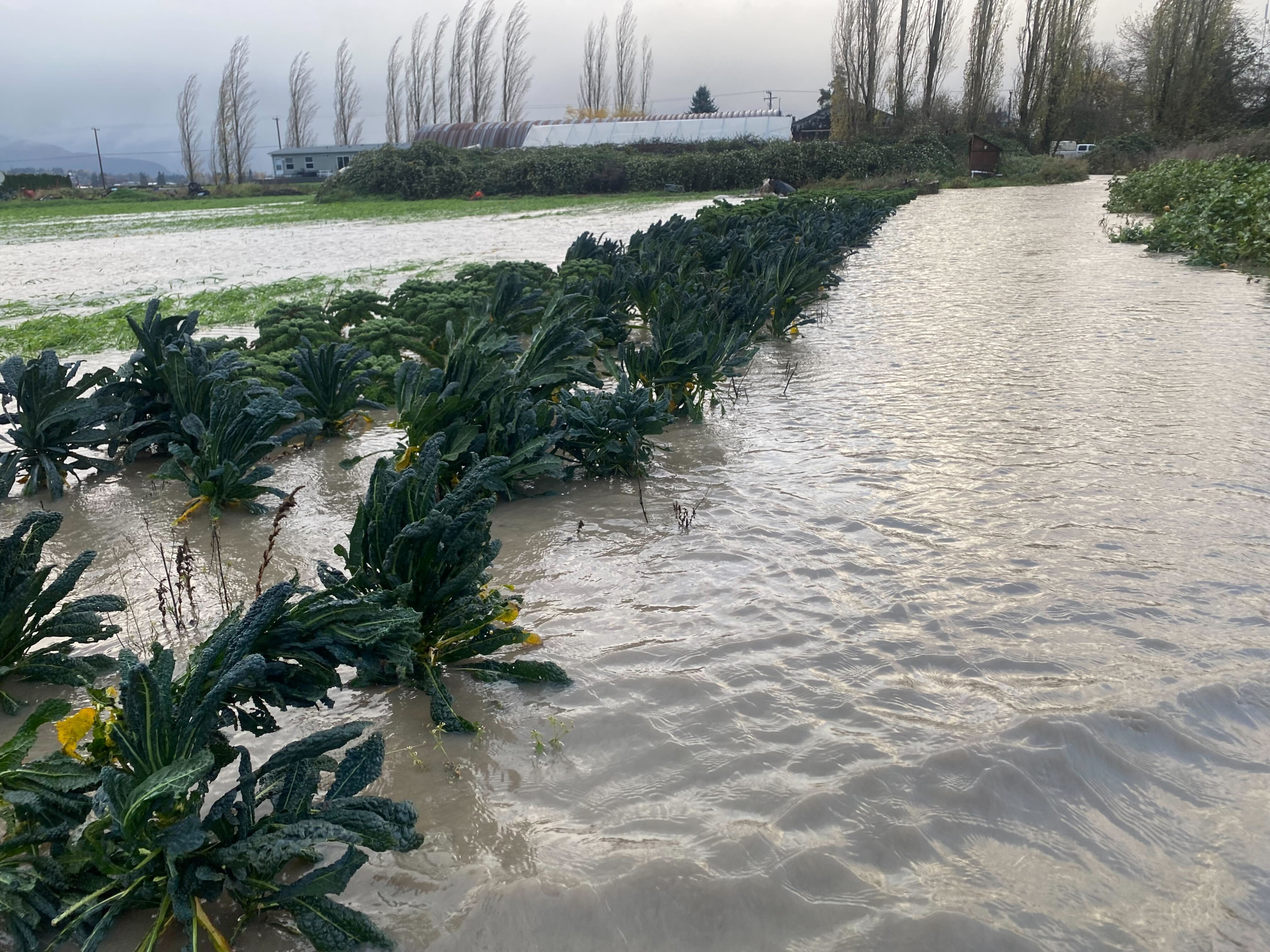
“We’re one of the the lucky ones”
Corry Spitters – Oranya Farm, Abbotsford
We had no notice. When it hit that morning, I was out at our feed mill. It was raining cats and dogs. We never thought it was going to get worse than what it was, but that was before the Nooksack breached. When the Nooksack broke, it happened in less than an hour, and by then we couldn’t go up and down the road anymore. There was no time to react.
We had no warning, no preparation for something like this. This has happened before, and we’ve come very close in the last few years with rainfalls and flooding where the water was almost breaching the road. If we had some notice, we could have salvaged a lot of equipment to higher ground. Our organic farm is inside of what is the Sumas lake, on the southern beach. We would have been safe except for the Sumas river dike breaking and then flooding the eastern portion of Sumas Prairie, the lakebed.
Oranya Farms is one of the lucky ones. Where our farms are located, the depth of destruction was less. There were guys with eight or nine feet of water, where we had only two or three. Fortunately, we didn’t lose a lot in the service side of things. All of our generators and electrical systems were compromised. We have our own water system, and we are one of the few who didn’t lose power. We are big enough that we have some resiliency and spare equipment. We had some outside help. The army came in—our farm was the one you saw on the news with the military moving birds.
It was more than two weeks before we could start clean up. When we could, we were able to get to work, first removing the mortalities and manure in the flooded floors. Clean-up was a mess, with every manure pit flooded out, every septic flooded out, three inches of sludge. We’re still working on fixing the barns, where we need to replace the insulation, disinfect the walls, and replace damaged wall sections. We also had three houses compromised with flood water, two which could be condemned—we are waiting for the adjuster’s opinions.
Physically, we will get through this.
Some people, like Dave Maartens, another conventional broiler farmer, have to rebuild their whole barns. He was underwater up to the second floor for three weeks. He has to redo all his wiring, and has a month or more wait for a new generator. Legally, you can’t run a chicken farm without a standby generator—the minute you lose power, you have a very short window where those birds will survive. We are completely at the mercy of our control computers for heating, cooling, managing the environment.
Fortunately for dairy and chicken, we do 24-7 yearly production—we’re not all in or all out, we have a return of our cashflow quickly. Vegetable producers who planted fall crops may have lost 50 percent or more of their annual revenue. Most field crop people don’t have the same luxury of resources we do. The turf farm next to us has at least 3 inches of sludge on his turf, vegetable farmers the same. Most of it is manure, but we don’t know what else is in there. There is a question of what that means for organic producers, for soil health and remediation.
Dairy recovery is not going to be as bad, but again, if you don’t have power, you can’t milk cows. It’s the weakest link in the chain that can stop your production.
The flood has been devastating. We are still waiting to see the full financial impact of the losses, but it will be substantial. We lost almost 200,000 birds, most which were within three weeks of shipping. We’re now fully back in production, after getting our first new set of chicks at the beginning of December.
We were completely taken off guard and totally unprepared. We could have mitigated a lot of the trouble that farmers had out there if we had been given better warning, and possibly had a plan in place for just such an event. We will be doing one on our own for our farms in the flood plain for possible future events, God help us!
If you talk to farmers in Sumas Prairie, they all say this shouldn’t have happened. The government has known for 30 years that the dikes needed fixing, since the last flood in the early ‘90s. There was a complete lack of oversight on the US side, where they have known for a long time that the Nooksack needs to be addressed. The people living in Sumas Prairie would like to see something said about what was known—what could have been done, what should have been done.
The municipality did nothing physically to assist farmers with the evacuation—if anything, they hindered farmers getting their livestock out of harm’s way. The policy is to appease where the population is and the farmer doesn’t even get the short end of the stick. But they are starting to realize it’s about more than the farmer. Maybe now they will take these things more seriously.
The community, on the other hand, did a tremendous service in assisting each other.
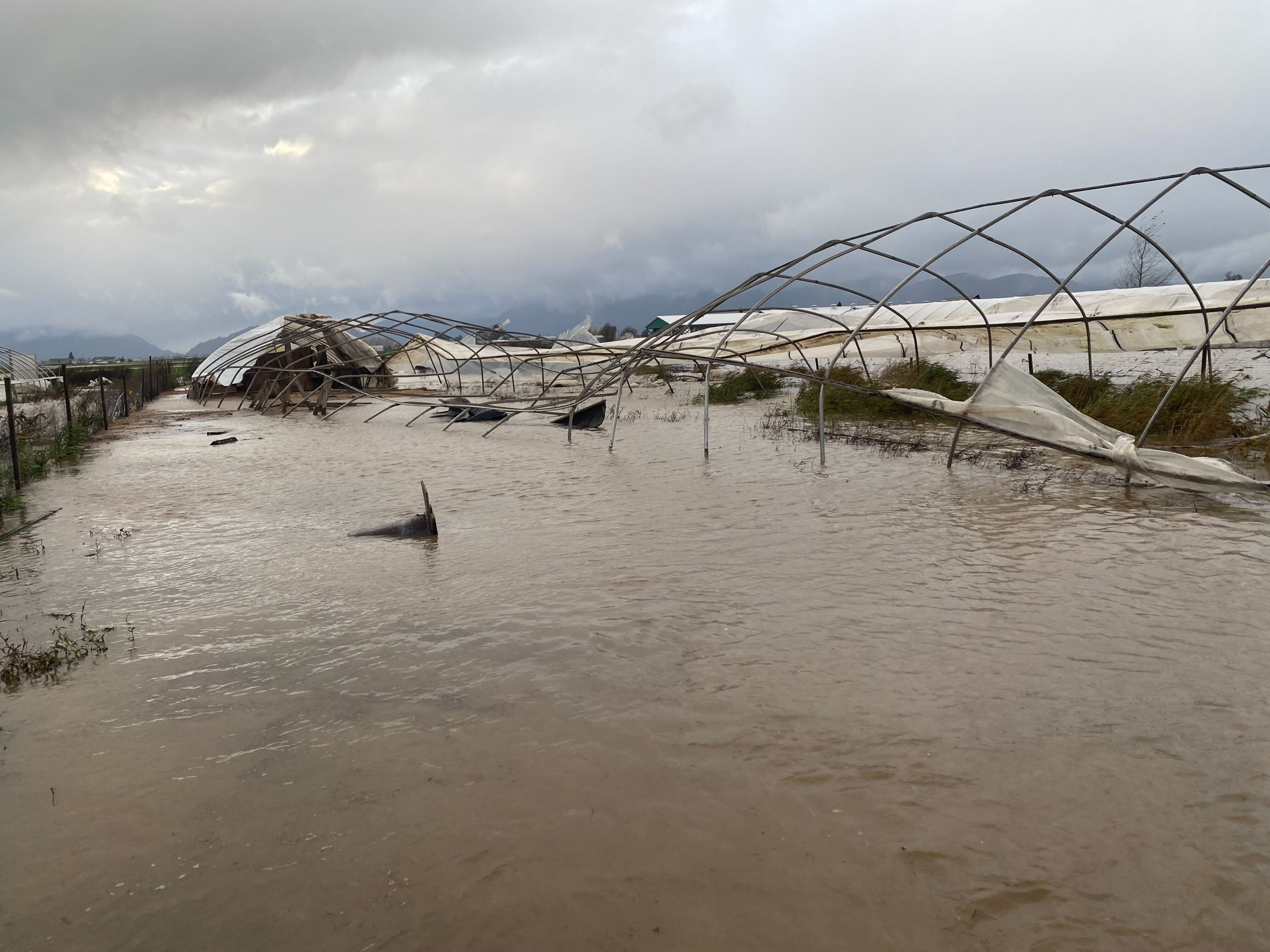
Supporting Our Small-Scale Food Heroes
Brodie Irvine – Discovery Organics
Supply chain and distribution capabilities have been drastically affected by road closures, infrastructure damage, and flooding. Moving produce around our province and outside of our province is now very difficult.
Customers east and north of Hope are having their produce orders routinely delayed and what used to be a one-day ship for delivery is now a minimum of two to three days and in some cases delayed up to six days. That is for produce being shipped from our Vancouver distribution warehouse.
This is making it extremely difficult for our customers to accurately order their produce needs. With multiple suppliers it has meant that with the delays, customers are going days without fresh produce arrivals and then getting multiple orders arriving at the same time. They are then overstocked with aged product that took too long to get to them.
Most of our customer base are independent small retailers and natural food stores that already have a hard time competing with large national retail grocery stores in their communities. The economic and business impact this disruption is having on them cannot be understated. They are essential food hubs supporting local agriculture in their communities, and without them food security within our province is even weaker. We need to do all we can to help them survive this and perhaps even support them more to ensure their success for years to come.
Thankfully, Discovery Organics has opened up a second distribution warehouse in Calgary, Alberta to increase our resiliency and food security, especially through the challenging winter months when freight disruptions and temperature issues often plague the quality and success of moving produce around Western Canada. We turned on the coolers to this warehouse days after the disaster on November 16th.
From our Calgary warehouse we were able to reinstate one-day delivery service to the Prairies, as well as large sections of the Interior of BC (the Okanagan, Golden, Revelstoke) and two-day delivery service to the Kootenays. This has been a herculean effort of freight partners, customers, and Discovery Organics staff all pulling together and being agile and creative.
Above all, the supply chain fallout from the floods exemplifies the importance of food security and supply chains, and that that comes most strongly from small independent organizations that are diverse, creative, and willing to take tremendous risks. They are the ones that we need to support. Folks like Hope Farm in Newlands. Wild Flight Farms in Armstrong, Farmer Cam in Terrace.
Those folks bailed out their communities with a plethora of produce. If the small-scale farmers aren’t the heroes of this story then I don’t know who is.
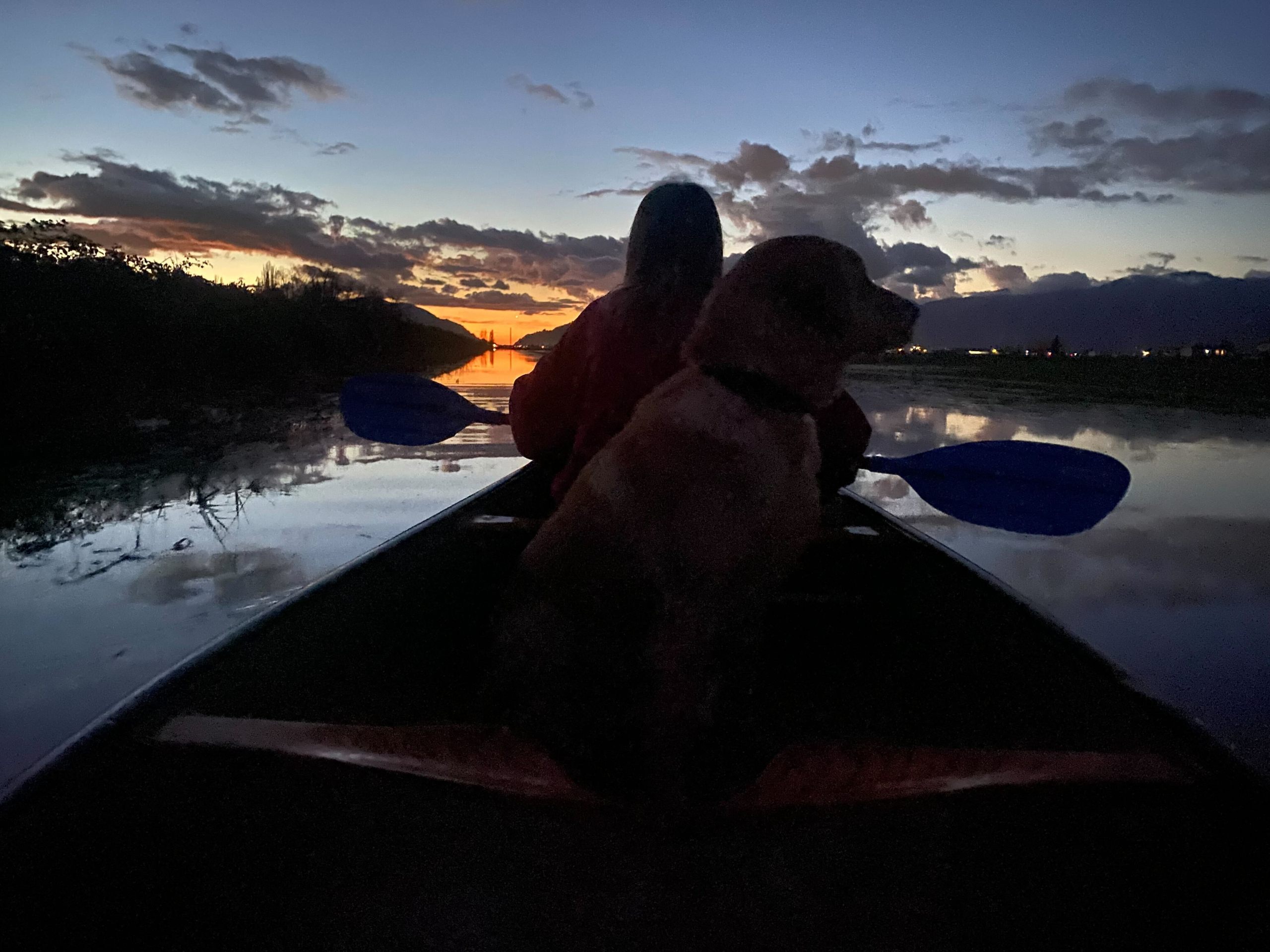
Climate Refugees
Michael, Brandie, and Luna – Monkey in the Garden, Spences Bridge
We are terribly heartbroken. We have just come out from total devastation and carnage. Our farm has been completely destroyed.
We were relaxing in the evening when we noticed that the river was rising. In the morning the water was still rising—higher than in the spring when the thaw would happen.
After morning milking, we noticed that the river was coming up into the yard where our bees and two chicken coops were. Next, the water was running between the raised beds of our garlic crop. We joked about flood irrigation working in this system. After a while the garlic beds with 55 planted pounds of our beautiful garlic were all under water. “What a loss,” we thought.
We watched as our few huge evergreens along the river toppled and washed away. A short while later Brandie let me know that the first chicken coop was gone—vanished. It was shortly followed by the second coop. Soon the water was running through our lower orchard.
Meanwhile, the water was rising and rising up towards the house on high—an incredible never before rising of the water. “Chocolate syrup from hell,” said Luna, as it crested our banks frothily.
In the late afternoon milking was happening. The water at that time was moving into the goat and cow barn. I decided to open up the electric fence so that they could jump out if they needed. At that point, the water breached the bank up at our house.
We hurried up to the house to open the door with a foot of water in our kitchen and sunporch. We moved a bunch of stuff up off the ground, moved our vehicles to the top of the driveway, grabbed our valuables and blankets, and spent a cold wet miserable night sleeping in our vehicles, listening to the sounds plop plop plop crash, which was the land eroding and buildings disappearing. Brandie and I were barely sleeping, expecting that our house was going to fall into the river.
Late in the night we both headed out into the moonlight and were relieved to see the light reflecting off of our metal roof on the house. The house was and is safe and secure, though there is a lot of water trapped in the sunporch.
In the morning the devastation was realized. Eight chicken coops and barns, our wellhouse (with our glorious pure cold water), the greenhouse, our shop, 300 fruit trees, 60 chickens and turkeys, our glorious gardens with the many years of soil building—all gone, including the very land that they sat upon. About four acres has completely vanished into the river leaving steep, eroding cliffs 20 feet down to the water. Never in our wildest imaginings could we dream of such devastation.
We had to make the tough choice to leave. We packed as much of our most valuable foods and some clothes. We took hundreds of pounds of the produce that we had grown all season and dumped it outside for our animals, as we knew that the food would be wrecked with the cold weather. All the fresh milk, dumped out for the chickens in buckets.
That night we had a little sleep and got to it again through the morning preparing for a helicopter which might land. We said our goodbyes to our cozy home, knowing it might be a long while until we saw it again. Tearful goodbyes and apologies to our animal friends for not being able to take them along with us.
In the early afternoon the helicopter landed. It was extremely frantic as the rush was on for us to haul our supplies to the helicopter… We had packed heavily 16 wheels of hard aged cheese that Brandie had laboured over the last year, sacks of garlic, onions, carrots, beets, parsnips, sweet potatoes, dried fruits, tea herbs—whatever we could grab that would give us a feeling of home during our exodus.
Now we’re refugees with no chance to return home for at least a year or two. We’ll be taking this opportunity to visit friends and family and see the ocean (which Luna hasn’t visited since she was a baby). Once the highway is repaired we’ll be heading back to rebuild the farm. In this time, we’ll be raising funds in any way possible to make it happen as quickly as possible. We have a well to dig, concrete retaining wall to build in front of the house to protect against future floods, a barn and coop to build, fencing to put up, trees to plant, soil to build, and our life to put back together.
Feature image: Oranya Farms on Nicomen Island devastated by flood. Credit: Oranya Farms.


